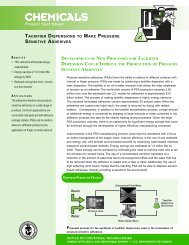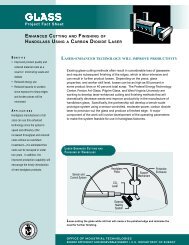PROCEEDINGS - Industries of the Future - West Virginia - West ...
PROCEEDINGS - Industries of the Future - West Virginia - West ...
PROCEEDINGS - Industries of the Future - West Virginia - West ...
Create successful ePaper yourself
Turn your PDF publications into a flip-book with our unique Google optimized e-Paper software.
Inaugural Symposium Poceedings<br />
2. Casting - technologies<br />
• Assist Steel <strong>of</strong> <strong>West</strong> <strong>Virginia</strong>, Inc. in <strong>the</strong>ir near net shape casting development<br />
3. Galvanized steel - white rust<br />
• Develop non-chromium based chemical passification. Seek assistance from<br />
chemical industry<br />
4. Process control sensors<br />
• Establish workshop for information transfer<br />
5. Roadmap review<br />
• Establish group from WVU to review and determine where university can assist.<br />
6. Workforce upgrade<br />
• Use WV Steel Advisory Commission<br />
Glass Industry Group Breakout Session<br />
Session Co-Chairs: Beri Fox <strong>of</strong> Marble King, Inc., Paden City, WV<br />
Tom Fenton <strong>of</strong> Fenton Art Glass Company, Williamstown, WV<br />
Theo Johnson, U.S. DOE, Office <strong>of</strong> Industrial Technologies<br />
Ed Sneckenberger, WVU, Mechanical and Aerospace Engineering<br />
B. Gopalakrishan, WVU, Industrial and Management System Engineering<br />
Introduction<br />
Theo Johnson informed <strong>the</strong> group that participants from industrial companies in <strong>the</strong> on-going<br />
national-level program can be grouped into three categories: 1) Chief Executive Officer <strong>of</strong> Company,<br />
etc, 2) Vice President <strong>of</strong> R&D, etc, and 3) Lead Production Person <strong>of</strong> Plant, etc. The percentage <strong>of</strong><br />
industrial participants in each category is currently about 10, 30 and 60%, respectively; <strong>the</strong>se<br />
percentages need to become closer to 50, 30 and 20%, respectively, so that a company's commitment<br />
to IOF projects is more assured. Participants from academic institutions, national laboratories and<br />
external suppliers were important contributors to <strong>the</strong> overall scheme and success <strong>of</strong> <strong>the</strong> national-level<br />
program, and <strong>the</strong>ir involvement in <strong>the</strong> state-level programs is encouraged.<br />
Basically, <strong>the</strong> glass industry for <strong>the</strong> national-level IOF has been defined into four segments: Flat<br />
Glass, Fiberglass, Container Glass, and Pressed/Blown (Specialty) Glass. Trade organizations such as<br />
<strong>the</strong> Glass Packaging Institute (GPI) <strong>of</strong> Washington, DC and <strong>the</strong> Society for Glass Science and<br />
Practices (SGSP) <strong>of</strong> <strong>West</strong>on, WV provide leadership for some <strong>of</strong> <strong>the</strong>se segments. Currently,<br />
however, none <strong>of</strong> <strong>the</strong>se organizations is a recognized lead association for <strong>the</strong> entire glass industry. The<br />
American Ceramic Society (ACS) <strong>of</strong> <strong>West</strong>erville, OH has <strong>of</strong>fered to be <strong>the</strong> single-voice association for<br />
<strong>the</strong> glass industry. Alternatively, a new Glass Industry Technical Council (GITC) has been proposed.<br />
Projects <strong>of</strong> interest to <strong>the</strong> glass industry participants for <strong>the</strong> national-level program have focused<br />
on four areas: Production Efficiency, Energy Efficiency, Environmental Protection/Recycling, and<br />
Innovative Uses. The team leaders, respectively, for <strong>the</strong>se four areas <strong>of</strong> project interest are Vince<br />
12






